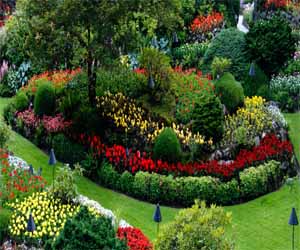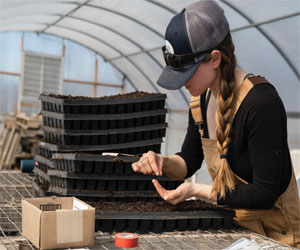


Nurturing A Sustainable Tomorrow

In an age of rapid environmental change and growing ecological awareness, eco-conscious living has emerged as a vital way for individuals to make a positive impact on the planet. This lifestyle prioritizes sustainability, environmental responsibility, and a deep respect for the natural world. By adopting eco-conscious practices, individuals can significantly contribute to the collective efforts to safeguard our environment and create a healthier, more sustainable future.
Eco-conscious living centers around reducing one's environmental footprint. This means making thoughtful choices in daily life to minimize waste, pollution, and resource consumption. Key principles of eco-conscious living include:
Reduce, Reuse, Recycle: The famous "Three R's" serve as the foundation of eco-conscious living. Reducing waste through mindful consumption, reusing items when possible, and recycling materials are essential practices that help divert waste from landfills and conserve valuable resources.
Energy Efficiency: Reducing energy consumption not only saves money but also reduces greenhouse gas emissions. Simple steps like using energy-efficient appliances, sealing drafts in homes, and turning off lights and electronics when not in use can make a significant difference.
Sustainable Transportation: Opting for eco-friendly modes of transportation, such as biking, carpooling, or using public transit, can help reduce air pollution and the carbon footprint associated with personal travel.
Mindful Consumption: Eco-conscious individuals make deliberate choices when it comes to the products they buy. They prioritize environmentally friendly and sustainably sourced goods, supporting companies that adhere to eco-conscious principles.
Conservation Of Water: Water is a finite resource, and eco-conscious living encourages water conservation through efficient fixtures, rainwater harvesting, and responsible water use practices.
Local And Organic Foods: Supporting local and organic food production not only reduces the carbon footprint associated with food transportation but also promotes healthier eating and sustainable agriculture.
Eco-Friendly Energy: Harnessing renewable energy sources, such as solar panels and wind turbines, is a significant aspect of eco-conscious living. It reduces reliance on fossil fuels and lowers energy costs.
Eco-conscious living extends beyond individual actions; it fosters a sense of community and collective responsibility. Many eco-conscious individuals engage in environmental activism, conservation efforts, and sustainable community initiatives. These efforts include planting trees, participating in beach cleanups, advocating for environmental policies, and working together to address local and global environmental challenges.
This lifestyle also emphasizes a deep connection with nature. People who adopt eco-conscious living often spend more time outdoors, cultivating an appreciation for the natural world and a desire to protect it. They seek to live in harmony with the environment, recognizing that our well-being is intimately connected to the health of the planet.
Eco-conscious living is not just a lifestyle choice; it's a commitment to creating a sustainable, environmentally responsible future. By embracing eco-conscious practices and supporting collective efforts to protect the Earth, individuals can be powerful agents of positive change. Eco-conscious living is not only about personal choices but also about shaping a better world for future generations. It is a way of life that promotes a harmonious coexistence between humanity and the planet we call home.
Thriving In Compact Living
 1. Multifunctional Furniture
1. Multifunctional Furniture
One of the key principles of small space efficiency is multifunctional furniture. These pieces serve multiple purposes, allowing you to make the most of every square inch. Sofa beds, fold-out desks, and dining tables with hidden storage are excellent examples. They provide comfort and functionality without monopolizing valuable space.
2. Vertical Storage
Utilizing vertical space is a game-changer in small spaces. Wall-mounted shelves, cabinets, and hooks create storage opportunities while keeping the floor area open and uncluttered. Vertical storage can also lend a sense of height and depth to your small space, making it feel more expansive.
3. Clear Clutter Regularly
Living in a small space necessitates regular decluttering. Be selective about what you keep, and embrace the philosophy of "less is more." Donate or sell items you no longer need, and make a conscious effort to prevent new clutter from accumulating.
4. Dual-Purpose Rooms
In small homes, one room often serves multiple functions. For instance, your living room might double as a home office, or your bedroom may also function as a gym. Careful planning and the use of flexible furniture can help you transition seamlessly between these different roles.
5. Custom Storage Solutions
Small spaces often require custom storage solutions. Investing in customized cabinets, built-in shelves, and under-stair storage can help you maximize every available nook and cranny. Tailoring your storage to your specific needs can make a significant difference in small space efficiency.
Creating A Beautiful And Thriving Garden
 Define Your Garden's Purpose: What do you want to achieve with your garden? Are you looking to create a lush, private retreat, or do you aim to grow a bountiful vegetable garden? The purpose of your garden will greatly influence your plant selection. For example, a meditation garden may focus on fragrant and low-maintenance plants, while a vegetable garden will prioritize edible crops.
Define Your Garden's Purpose: What do you want to achieve with your garden? Are you looking to create a lush, private retreat, or do you aim to grow a bountiful vegetable garden? The purpose of your garden will greatly influence your plant selection. For example, a meditation garden may focus on fragrant and low-maintenance plants, while a vegetable garden will prioritize edible crops.
Choose Plants That Thrive In Your Climate: Plants that are native or well-suited to your climate are more likely to thrive. Native plants are adapted to the local conditions and require less maintenance. They also support local wildlife and pollinators.
Consider Growth Patterns: When selecting plants, consider their growth habits. Some plants are compact and tidy, while others can be sprawling or invasive. Be mindful of how each plant will fit into your garden's design and its potential impact on nearby plants.
Balance Aesthetics: Think about the visual appeal of your garden. Balance is essential. Choose a variety of plants that offer different colors, textures, and heights.
Cleaning Your Way To A Sustainable Future
 Non-Toxic Products: Green cleaning relies on cleaning products that are free from harmful chemicals and synthetic fragrances. These products are safer for your health and the environment.
Non-Toxic Products: Green cleaning relies on cleaning products that are free from harmful chemicals and synthetic fragrances. These products are safer for your health and the environment.
Reduced Environmental Impact: Green cleaning minimizes the use of harsh chemicals that can contaminate water systems and contribute to pollution. It also promotes the use of eco-friendly cleaning tools and practices.
Clean Indoor Air: Green cleaning products and methods focus on improving indoor air quality by avoiding the release of volatile organic compounds (VOCs) commonly found in traditional cleaning products.
Effective Green Cleaning Techniques
Natural Cleaning Solutions: Utilize natural ingredients like white vinegar, baking soda, lemon juice, and essential oils to create your cleaning solutions. For example, a mixture of vinegar and water can serve as an excellent all-purpose cleaner.
Reusable Cleaning Tools: Invest in high-quality reusable cleaning tools, such as microfiber cloths and mop heads. These tools effectively capture and remove dirt, dust, and allergens, reducing the need for disposable cleaning supplies.
Reduced Plastic Waste: Opt for cleaning products and containers that are recyclable or refillable to reduce plastic waste. Single-use plastic bottles contribute to environmental pollution, and green cleaning encourages responsible consumption.
Energy-Efficient Appliances: Choose energy-efficient cleaning tools and appliances. For instance, energy-efficient vacuum cleaners and steam cleaners use less energy while providing effective cleaning.
Cultivating A Passion For Gardening
 Defining The Green Thumb
Defining The Green Thumb
A "green thumb" is a colloquial term that signifies a person's natural aptitude and success in gardening. Those with green thumbs seem to effortlessly grow thriving plants, lush gardens, and abundant crops. They have a knack for understanding the needs of plants, diagnosing issues, and nurturing them to flourish. Many people believe that this ability is an inborn talent, but the reality is more nuanced.
The Science Of Green Thumbs
While some individuals may have a more intuitive understanding of plants due to their upbringing or exposure to gardening from a young age, the concept of the green thumb is not solely based on genetics. Instead, it is rooted in knowledge, experience, and a deep appreciation for the natural world.
Education: Green thumbs often have a solid understanding of horticulture, botany, and gardening techniques. This knowledge allows them to make informed decisions about planting, soil preparation, and care.
Observation: Successful gardeners pay close attention to their plants. They observe growth patterns, spot issues early, and take corrective action, ensuring that plants receive the right care.
Experimentation: Green thumbs aren't afraid to try new things. They experiment with different plants, techniques, and approaches to discover what works best in their specific environment.
Patience: Gardening requires patience and dedication. Green thumbs are willing to invest time and effort in their gardens, understanding that success often comes with experience.
 The Rise Of Greenhouse Farming
The Rise Of Greenhouse Farming
Greenhouse farming, also known as protected cultivation, has witnessed a significant surge in popularity over recent decades. This surge can be attributed to several factors, including the increasing demands for year-round crop production, the need for protection against adverse weather conditions, and the conservation of resources in a sustainable manner.
Year-Round Crop Production
One of the most notable advantages of greenhouse farming is the ability to grow crops throughout the year, regardless of the external climate. Greenhouses provide a stable and controlled environment where temperature, humidity, and light levels can be regulated to meet the specific needs of different crops. This means that farmers are not restricted to the traditional growing seasons, leading to increased crop diversity and a more reliable food supply.
Optimal Environmental Control
Greenhouses offer precise control over environmental factors. With advanced climate control systems, farmers can adjust temperature, humidity, and CO2 levels to create ideal conditions for plant growth. This level of control minimizes the impact of extreme weather events, pests, and diseases, resulting in higher crop yields and quality. It also allows for the cultivation of crops that might not thrive in local climates.
Resource Efficiency And Sustainability
Greenhouse farming is inherently resource-efficient. By retaining heat and moisture, greenhouses reduce water usage and protect against soil erosion. Additionally, the controlled environment minimizes the need for chemical pesticides, as pests are kept at bay.